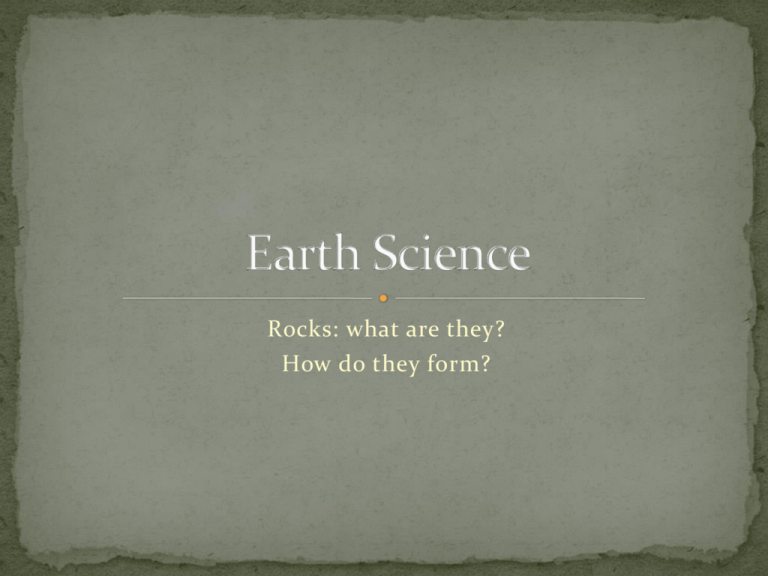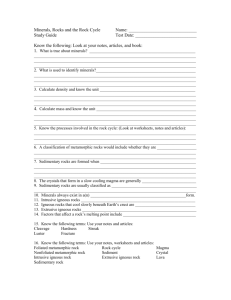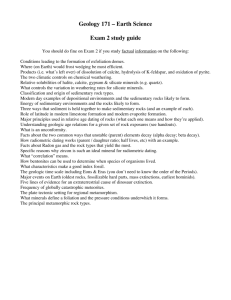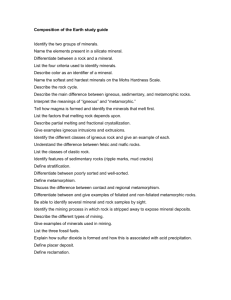Earth Science
advertisement

Rocks: what are they? How do they form? Rocks are aggregates of minerals…that is, they are made up of minerals but not in the same form as a collectible mineral specimen would be. There are three simple types: Igneous: crystallized from magmatic flows Volcanic or extrusive: above ground Intrusive: below ground Sedimentary: deposited from air and water Metamorphic: changed by heat and pressure from the original material; caution: if re-melting occurs, no longer metamorphic but a new igneous rock. Discussion points: look back at rock cycle: All three classes of rocks can weather and become sediments, which may form new sedimentary rocks with sufficient time. All three classes of rocks can melt and become magma, which may form new igneous rocks. All three classes of rocks can undergo metamorphosis and change into new metamorphic rocks, even if already metamorphosed before. These rocks form when magma or lava cools and hardens. Intrusive Igneous rocks: these form when magma cools under the surface of the Earth…they intrude into existing rock forms, regardless of type. They are also called Plutonic. They are typically exposed by erosion of overlaying material. Examples: Granite, Pegmatite, Gabbro, Diorite, Peridotite Extrusive Igneous rocks: these form when magma flows upon the surface as lava, or, if underwater, as Basalt. Examples: Basalt, Andesite, Rhyolite All of these rocks follow a range of chemical make-up, which is called Bowen’s Reaction Series…it allows us to realize how the rocks crystallize, and also tells us what minerals we can typically expect in a given exposure. As the temperature of the magma decreases, the minerals that crystallize out change, dependent upon their composition. Typically, those minerals with the highest amounts of “mafic” metals, Magnesium and Iron, tend to crystallize out first. As the magma/lava cools further, the minerals with less Mg, Fe, and more Ca start to crystallize, eventually shading into sodium, potassium, and aluminum bearing minerals. Also, as the temperature drops, the amount of silica increases in the minerals that are crystallizing out. Gravitational Differentiation: this is the process whereby the minerals that are crystallizing out settle out of the parent magma, which allows minerals to develop into zones in the final rock formation. This is how geologists and miners know how and where to look for various minerals and ores in rock formations. Fine-grained: aphanitic, where the mineral grains are too small to see without strong magnification. Coarse-grained: phaneritic, with clearly visible mineral grains. Aphanitic are typically extrusive/volcanic, phaneritic are typically intrusive/plutonic, but these textures can follow either type of igneous rock depending upon its individual location of formation…they are truly ranges which the magma/lava can vary widely. Phenocrysts: larger mineral grains, readily visible. Ultramafic: <45% silica, largely ferromagnesian silicates; generally dark green to black. Almost always plutonic. Basalt-Gabbro: 45-52% silica, typically darker rocks, Basalt is aphanitic, whereas Gabbro is phaneritic. Both are common at mid-oceanic spreading ridges. Andesite-Diorite: 53-65% silica, with Diorite showing a salt/pepper appearance of its crystals, while Andesite may be a more generic gray shade, with phenocrysts. Rhyolite-Granite: >65% silica, usually light colored except for dark, “accent” minerals, such as Biotite mica. Rhyolite (extrusive) is much rarer than the more mafic extrusive rocks (Basalt and Andesite). Rhyolite tends to be more often seen as a pyroclastic rock. Pegmatite: a variation of Granite (usually)where the crystals are quite large. Some are called complex pegmatites when elements are present which create less common minerals, frequently producing gem minerals of great value and beauty…Tourmaline, Beryl, Spodumene are examples. From the name, we can tell that sedimentary rocks are made from sediments…which can be weather derived particles from preexisting rocks, minerals from seawater-borne solutions, or minerals extracted from biological organisms. Regardless, sediments are loose aggregations of solids, which, when bound together become sedimentary rocks. As you might guess, many sedimentary rocks are named after the sediments that they are made from: sandstone from sand, siltstone from silt, mudstone from mud, limestone from lime-containing materials. Let’s think about sediments…these are transported materials Running water Wind Glaciers Waves Near shore currents Each of these generates their own type of deposited sediments, with its own typical characteristics…these characteristics are what enable us to determine the nature of the rock, and when it was formed in its environment, frequently what that environment was. Possibilities: Glacial: mountainous or plains Lakes Streams/rivers Beach Delta Tidal flat Sand dunes Alluvial fan Submarine fan Barrier island Deep marine Three options Compaction Cementation Both compaction and cementation together Compaction: the process of reducing the volume of the material…pore spaces are reduced, then eliminated, can have notable adhesion depending upon grain size. Compaction is enough for lithification for mud and silt, as their grain size is so small that adhesion will be achieved by this alone. Cementation: when a mineral or minerals crystallize in the pore spaces and serve as a binder on the sedimentary particles present. Both: self-explanatory, I hope. Common cementing minerals: Calcium carbonate: CaCO3 Silicon dioxide: SiO2 Iron oxides and hydroxides: Hematite: Fe2O3, Limonite: FeO(OH)-nH2O Two broad categories: detrital and chemical Detrital: made up of solid particles derived from existing rocks by chemical and mechanical weathering; they have a clastic texture, which means that they are composed of clasts, which are particles or fragments. Examples: conglomerate, sedimentary breccia, sandstone, mudrocks: siltstone, mudstone, claystone, shale. C. 40% of all sedimentary rocks are mudrocks. Chemical: resulting from inorganic processes or the chemical activities of organisms…sometimes called biochemical sedimentary rocks. May be either crystalline or clastic in texture. Carbonate rocks Limestone: CaCO3 Variations: Travertine: finely crystalline variant, found near hot springs Oolitic: formed from layers of ooids, spherical grains Coquina: entirely shell fragments Chalk: entirely microscopic shells Dolostone: CaMg(CO3)2 Thought to have occurred when the magnesium concentration in seawater increased due to calcium deposition. Evaporites: rocks formed by evaporation and the subsequent deposition of minerals Rock Gypsum: CaSO4·2H2O Rock Salt: Halite: NaCl Chert: SiO2, thought to be from chemical replacement of limestone by precipitation of silica from silicaceous organisms. Coal: a biochemical sedimentary rock: starts out as peat deposits (50%C), further altered into lignite (70%C), then bituminous coal (80%C), finally to anthracite (98%C). Metamorphism is from the ancient Greek for change of form/shape. This usually is exhibited by the recrystallization of minerals within a preexisting rock. This process occurs with heat, pressure, fluid activity, and time. Metamorphism occurs when there is a change in the physical or chemical environment of a rock, which then results in a “changed” rock, the result of which is a new rock, more stable for the conditions. Metamorphic fluids are under high temperature and pressure, so these are frequently only a few molecules thick as they move in rock where there is little porosity. Contact/thermal: occurs when a body of magma alters the surrounding country rock, so extent of metamorphism will be dependent upon the size of the igneous intrusion. This area is called an aureole and can range from centimeters to kilometers. Metasomatism: when the bulk composition of the rock changes due to sufficient high temperature fluid interchange. Dynamic: pressure-dominated metamorphism, commonly associated with fault zones and the adjacent rocks. Minerals frequently have a smeared appearance. Shock: metamorphism due to meteorite impact. Regional/dynathermal: large area zones of metamorphism, usually due to converging plate boundaries, almost always showing a gradation of effect as distance from the convergence increases. Foliation: from Encyclopedia Brittanica: planar arrangement of structural or textural features in any rock type, but particularly that resulting from the alignment of constituent mineral grains of a metamorphic rock of the regional variety along straight or wavy planes. Foliation often occurs parallel to original bedding, but it may not be ostensibly related to any other structural direction. Foliation is exhibited most prominently by sheety minerals, such as mica or chlorite. Nonfoliation: self-explanatory Visit these sites: http://www.physicalgeography.net/fundamentals/10g. html http://www.rocksandminerals4u.com/metamorphic.h tml








